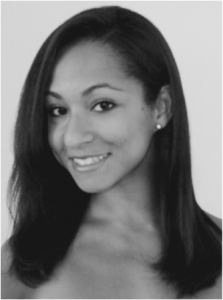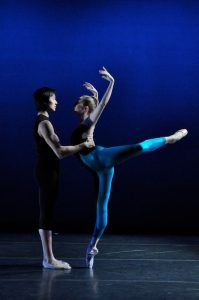
The young and incredibly talented Claudia Schreier will present her choreography on August 8-9 at the Ailey Citigroup Theater with an amazing cast of dancers from some of the top ballet companies around, including New York City Ballet, American Ballet Theatre, Dance Theatre of Harlem, Suzanne Farrell Ballet, and Los Angeles Ballet. On the program are three world premieres: Almost Morning, a piece with a commissioned score by House of Cards composer Jeff Beal; Vigil, performed with the 20-member choir Tapestry; and Pulse, set to Douwe Eisenga's Piano Concerto: I. The performance, which also includes two older works (Anomie and Harmonic), is presented by the Breaking Glass Project, awarded to Schreier after winning the 2014 Breaking Glass Project, a competition for emerging female choreographers. I had the pleasure to see sit in on a rehearsal and speak with the hardworking Harvard grad afterward about her work.
 How did you gather this cast of wonderful dancers?
How did you gather this cast of wonderful dancers?
I started off with a much smaller group, some of whom I worked with through Intermezzo Dance Company. Amber Neff is one of them and Kaitlyn Gilliland -- beautiful dancers. So I started with an incredible crew and it grew from there. My mentor through Breaking Glass, Deborah Wingert, brought me Lydia Wellington. A friend of mine who dances with New York City Ballet brought me Daniel Applebaum. A lot came through recommendation and the group grew as the process went along.
When introducing your work, you mentioned that you always have a purpose for everything you choreograph. Is that intent something you share with your dancers?
I share with them that the music is important. For the intent, that’s always where it starts. I don’t choreograph narratives, or if I do it is extremely abstract and gets even more abstract as I continue. Even looking at [older] works like Anomie, I see it as a work that exists in time; I like to refer back to it, but there are elements that I wouldn’t necessarily use now. And I think that’s perfectly fine. I feel like it is a representation of my work -- where I’ve been and where I’m going.
And what about Almost Morning, given that it is a collaborative work?
Almost Morning is probably the most narrative driven work in the series because I was provided by a score that I might not necessarily have chosen otherwise. The music has these elements that I had to delve deep into to discover my own voice within. Once I did, I discovered how much I connected with it. That’s been really wonderful. The title Almost Morning actually comes from the composer [Jeff Beal] because he has this beautiful story about how his four-year-old son woke up his uncle at four o’clock in the morning shaking him, saying, “Wake up! It’s almost morning!” That was his inspiration for the score and you can hear it throughout. I only learned that about three quarters of the way into the process. So, there are things that I did after learning the story and he changed the music after seeing some of my rehearsal videos, tweaked things here or there. The piece is probably the closest to narrative, but I still always start with the music. Always.
It sounds like the collaborative process with Jeff Beal was very positive.
The process could not have been more incredible. I feel incredibly spoiled because Jeff Beal is a mastermind. He is an absolute genius; he’s known for being an absolute genius and a wonderful human being all around.

Did anything about the process surprise you?
From the second we had our initial conversation to the end, it’s been a true collaboration in every sense of the word. It has propelled me forward in a way I hadn’t really expected. Having not composed for dance before, he brought a certain humbleness to the table. Even though he is so well known in the television, film, and concert communities, he sort of took this as a chance to step back and start from square one. We both went at this with arms wide open -- open mind and open heart. There wasn’t a single thing about the process that was difficult or taxing. If it was challenging, it was challenging in a good way. I cannot speak highly enough of Jeff. It is such an honor to work with him.
I see a lot of innovation in your partnering work. Can you tell us a bit about your inspiration for it?
In the past, I’ve always felt that my partnering work was lacking because I wasn’t a professional dancer. I grew up with very strict classical training and was a self-professed bunhead for many years until I went to college. That’s where I had more exposure to modern techniques and where my own choreographic range expanded. But I never danced professionally and so I didn’t have a lot of partnering training. I didn’t have the opportunities to execute that kind of movement. So, it took me a while to understand the mechanics of it and to do things that didn’t feel predictable. That’s what I’ve consciously worked on. Looking back at my earlier works, things that I thought were so brilliant at the time, I go back and realize it’s actually very much run of the mill. But I had to get through that, to self-teach before I could go beyond. I think with the partnering work in each piece, it’s pulling out the music, finding the suspensions, finding moments and then visualizing them.
What is something you’d like your audience to take away from the performance on Saturday?
To know how hard my dancers work and how committed they are to their art form and to the process. I could not have done this without them.
Claudia Schreier and Company perform at the Ailey Citigroup Theatre, August 8 and 9.